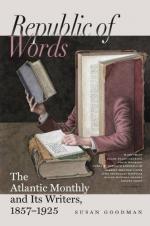Beside this full insight and representation of character, which makes the ideal portraiture, we have the less complete, but only in degree less valuable, apprehension which results from a point of sympathy, a likeness of liking in one or more fields of thought, a common sensitiveness, a common interest; and the rarer sympathy between artist and subject, of that intimacy and complete understanding of personal character, which, even where no great talent exists in the artist, gives a unique value to his work, but which, where the intimacy is that of great minds, gives us works on which no dilettanteism, even, makes a criticism,—as in that portrait of Dante by Giotto, to our mind the portrait par excellence of past time.
In the three admirable portraits whose titles stand at the head of our notice, we have in one way and another all of the conditions we have spoken of fulfilled. Rowse’s portrait of Emerson is one of the most masterly and subtile records of the character of a signal man, nay, the most masterly, we have ever seen. Those who know Emerson best will recognize him most fully in it. It represents him in his most characteristic mood, the subtile intelligence mingling with the kindly humor in his face, thoughtful, cordial, philosophic. The portrait is not more happy in the comprehension of character than in the rendering of it, and is as masterly technically as it is grandly characteristic. An eminent English poet, who knows Emerson well, says of it, justly,—“It is the best portrait I have ever seen of any man”; and we say of it, without any hesitation, that no living man, except, perhaps, William Page, is capable, at his best moment, of such a success.
In Barry’s portrait of Whittier it is easy to see the points of contact between the characters of the artist and the poet-subject, in the sensitiveness shown in the lines of the mouth in the drawing, in the delicacy of organization which has wasted the cheek and left the eye burning with undimmed brilliancy in the sunken socket, the fervent, earnest face, defying age to affect its expressiveness, as the heart it manifests defies the chill of time. It is an exceedingly interesting drawing, and one by which those who love the poet are willing to have him seen by the future. It must remain as the only and sufficient record of Whittier’s personnel.




